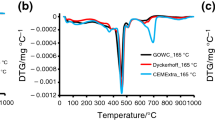Abstract
A curious feature of hydraulic cements, such as those based on calcium silicate, calcium aluminate and calcium sulphate, is that they exhibit similarly low flexural strengths, typically between 3 and 10 MPa, despite their differing chemical composition, varying degrees of hydration and contrasting setting mechanisms1–3. Because of these low strength values, unreinforced cements are never used in flexure or tension, and studies of cement strength are usually confined to compression. Those few studies which have considered flexural or tensile failure have concluded that hydraulic cements have an intrinsic maximum tensile strength of about 20 MPa4,5. Here we demonstrate that the commonly observed flexural weakness of cement is due to the presence of large voids which are largely undetected by conventional methods of pore analysis such as gas adsorption and mercury porosimetry. The removal of such macro-defects results in flex strengths up to 70 MPa, despite the large volume of gel pores remaining in the material. These strength figures, comparable with those of sintered ceramics, have been achieved without the use of elevated pressures or temperatures, and without fibrous reinforcement.
Similar content being viewed by others
References
Soroka, I. Portland Cement Paste and Concrete (Macmillan, London, 1979).
Neville, A. M. Properties of Concrete, 400–403 (Pitman, London, 1963).
Schiller, K. K. in Mechanical Properties of Non-Metallic Brittle Materials (ed Walton, W.H.) 35–49 (Butterworth, London, 1958).
Higgms, D. D. & Bailey, J. E. J. Mater. Sci. 11, 1995–2003 (1976).
Berger, R. L., Lawrence, F. V. & Young, J. F. Cem Concr Res. 3, 497–508 (1973).
Feret, R. Bull. Soc. Encouragement Indust. Nat. II 1604 (1897).
Abrams, D. Bull. Struct. Mater. Res. Lab. Lewis Inst. Chicago. No 1 (1918).
Powers, T. C. Proc. 4th int. Congr. Chem. Cement, Washington DC, 577–613 (US National Bureau of Standards Monogr. 43, 1962).
Sereda, P. J., Feldman, R. F. & Ramachandran, V. S. Proc. 7th int. Congr. Chem. Cement. Vol. 1, Principal Rep. V1-1 (3–44) (Editions Septima, Paris 1980).
Kendall, K. Proc. R. Soc. A361, 245–263 (1978).
Griffith, A. A. Phil. Trans. R. Soc. A221, 163 (1920).
Knudsen, F. P. J. Am. Ceram. Soc. 42, 376–387 (1959).
Davidge, R. W. Mechanical Behaviour of Ceramics (Cambridge University Press, London,1979).
Brown, W. F. & Srawley, J. E. ASTM Spec. Tech. Publ. 410 (ASTM, Philadelphia, 1967).
Rootare, H. M. Perspect. Powder Met. 5, 225–252 (1970).
De Hoff, R. T. & Rhines, R. N. Quantitative Microscopy (McGraw Hill, New York, 1968).
Winslow, D. N. & Diamond, S. J. Mater. 5, 564–585 (1970).
Diamond, S. & Dolch, W. J. Colloid Interface Sci. 38, 234–244 (1972).
Dullien, F. A. L. Proc. int. Symp. Rilem/IUPAC Pore Structure and Properties of Materials Vol 1, C173–186 (Academia, Prague, 1974).
European Patent Application No. 80301909.0 Imperial Chemical Industries Ltd (1980).
Author information
Authors and Affiliations
Rights and permissions
About this article
Cite this article
Birchall, J., Howard, A. & Kendall, K. Flexural strength and porosity of cements. Nature 289, 388–390 (1981). https://doi.org/10.1038/289388a0
Received:
Accepted:
Issue Date:
DOI: https://doi.org/10.1038/289388a0
- Springer Nature Limited
This article is cited by
-
A review of application of UHPFRC in bridges as an overlay
Innovative Infrastructure Solutions (2023)
-
High-pressure compacted recycled polymeric composite waste materials for marine applications
SN Applied Sciences (2022)
-
Flexural strength of silica fume, fly ash, and metakaolin of hardened cement paste after exposure to elevated temperatures
Journal of Thermal Analysis and Calorimetry (2022)
-
Controlled growth and ordering of poorly-crystalline calcium-silicate-hydrate nanosheets
Communications Materials (2021)
-
Performance evaluation of ultra-high performance concrete designed with alccofine
Innovative Infrastructure Solutions (2021)





